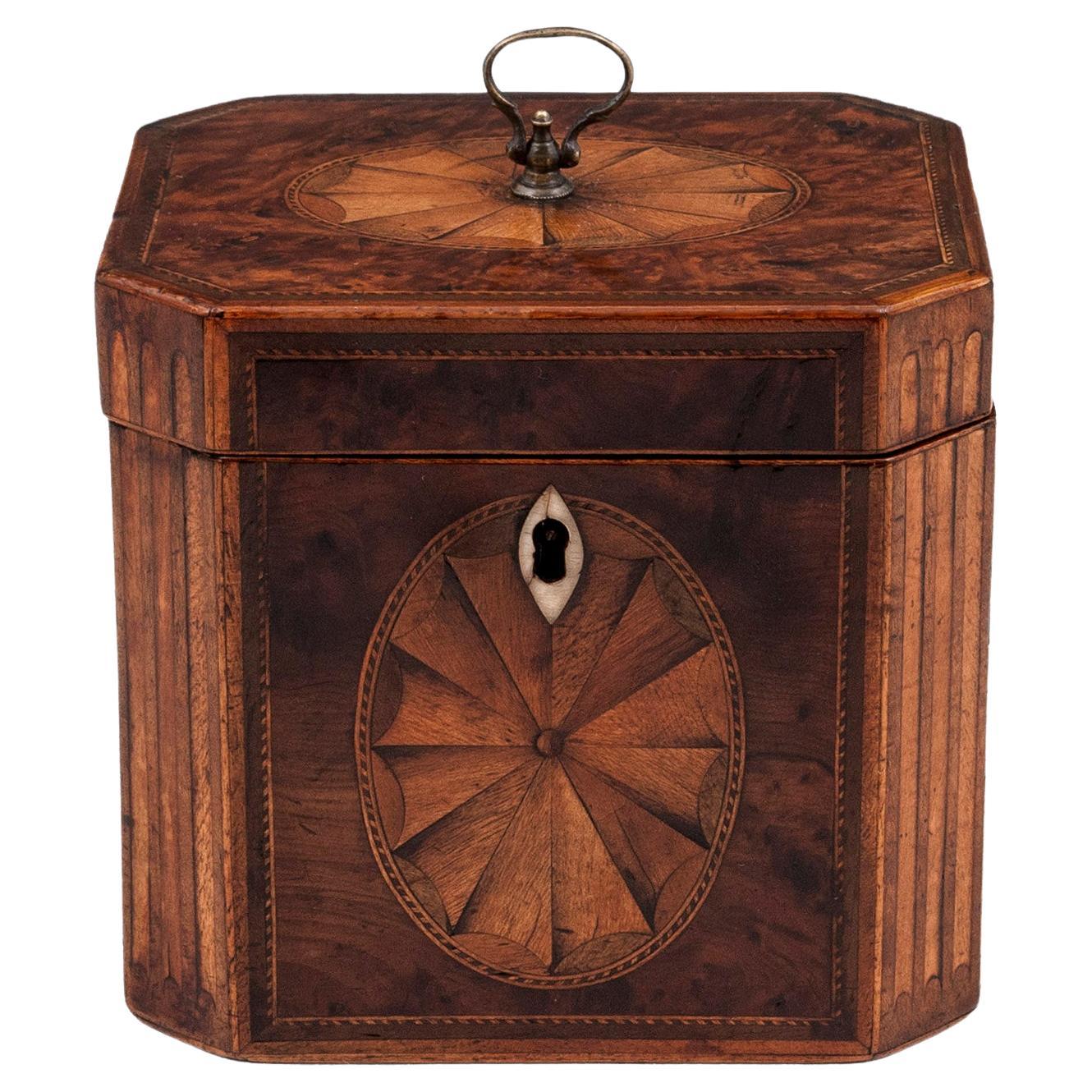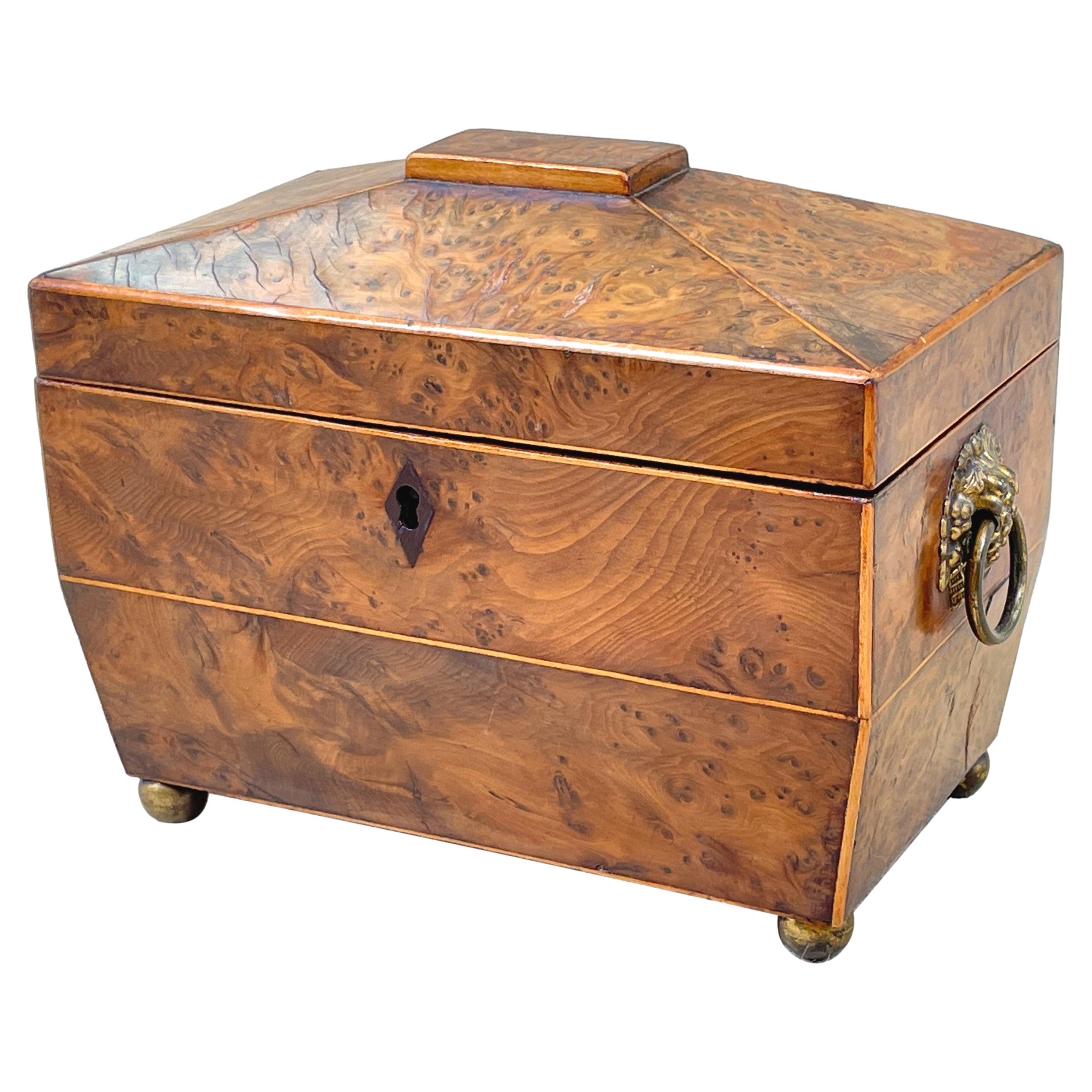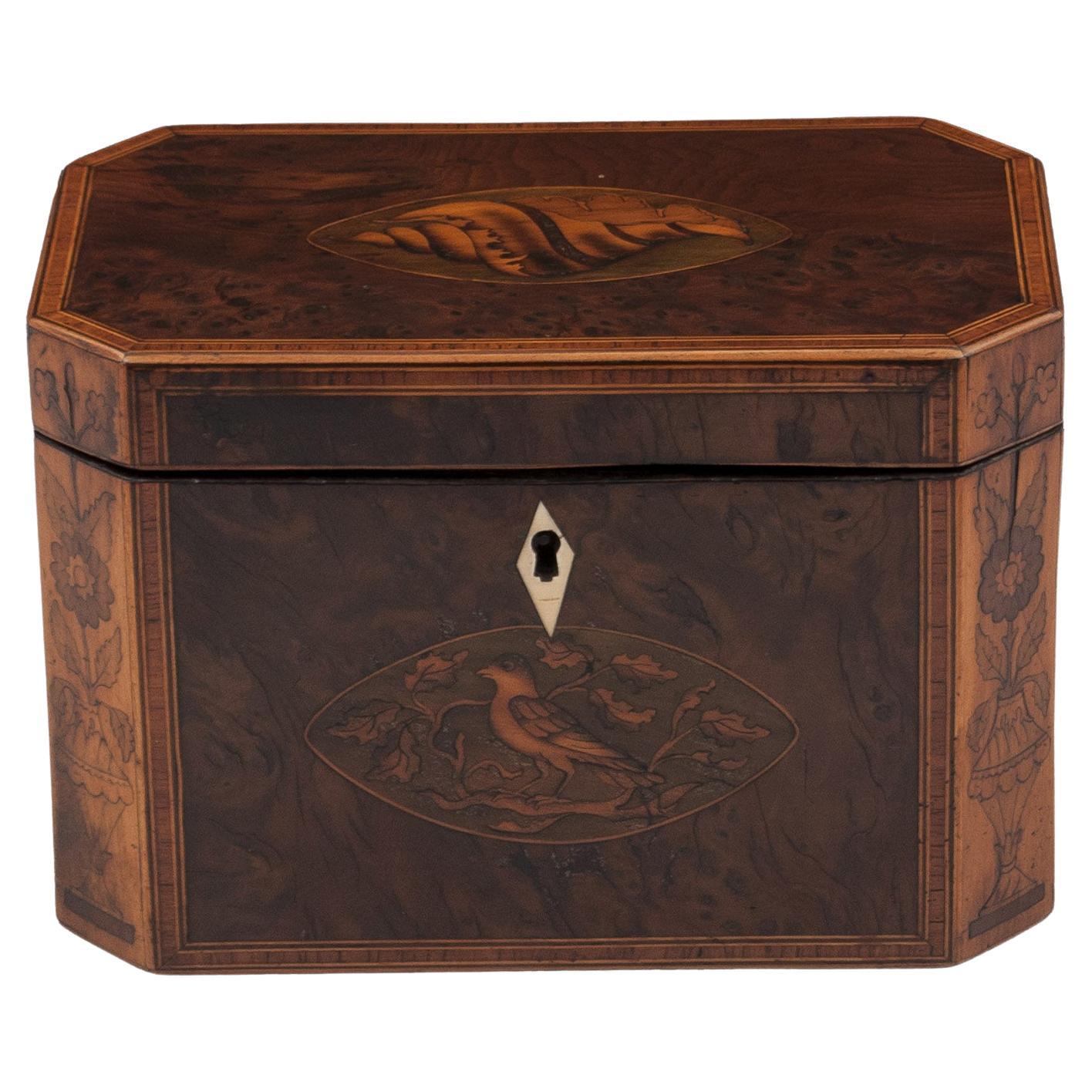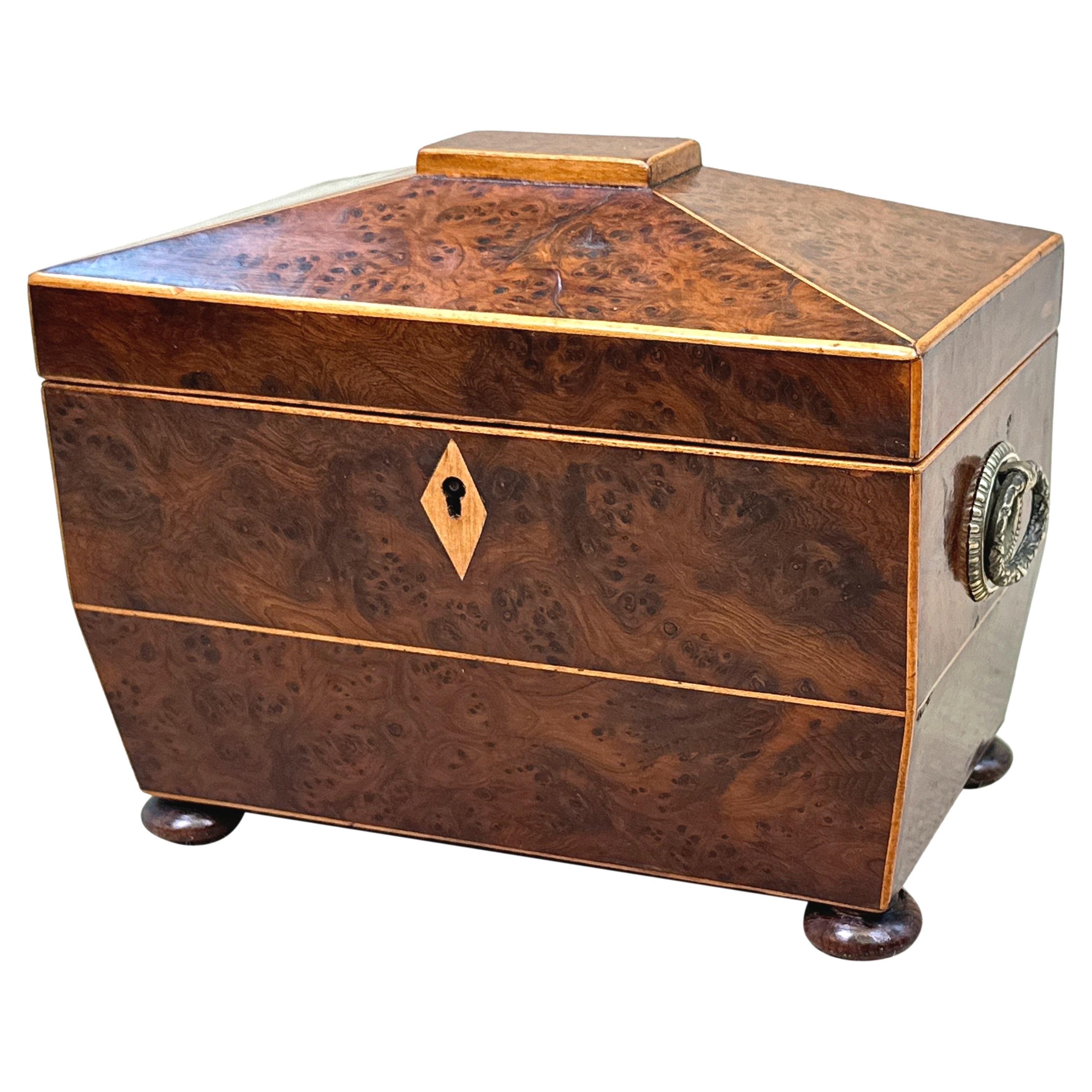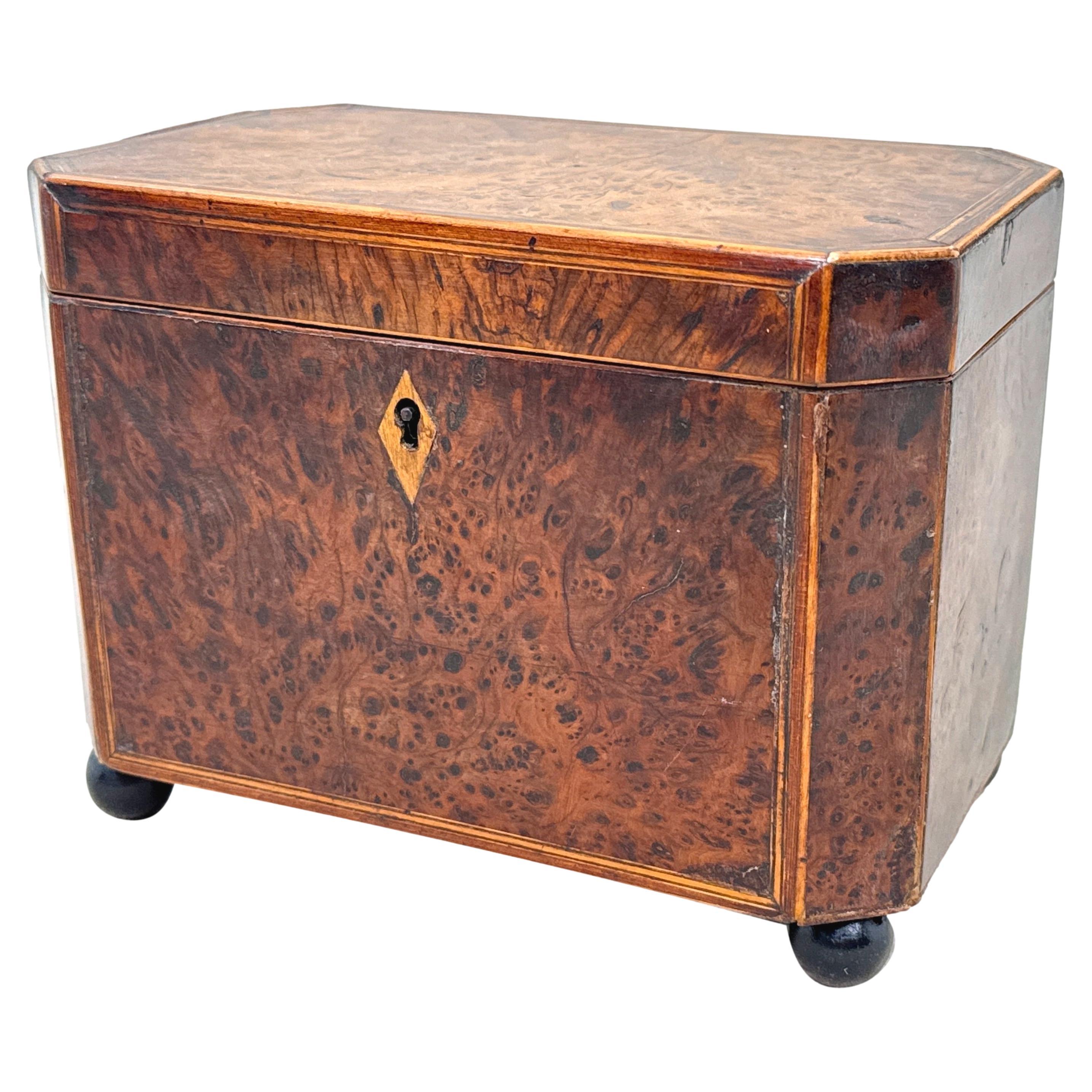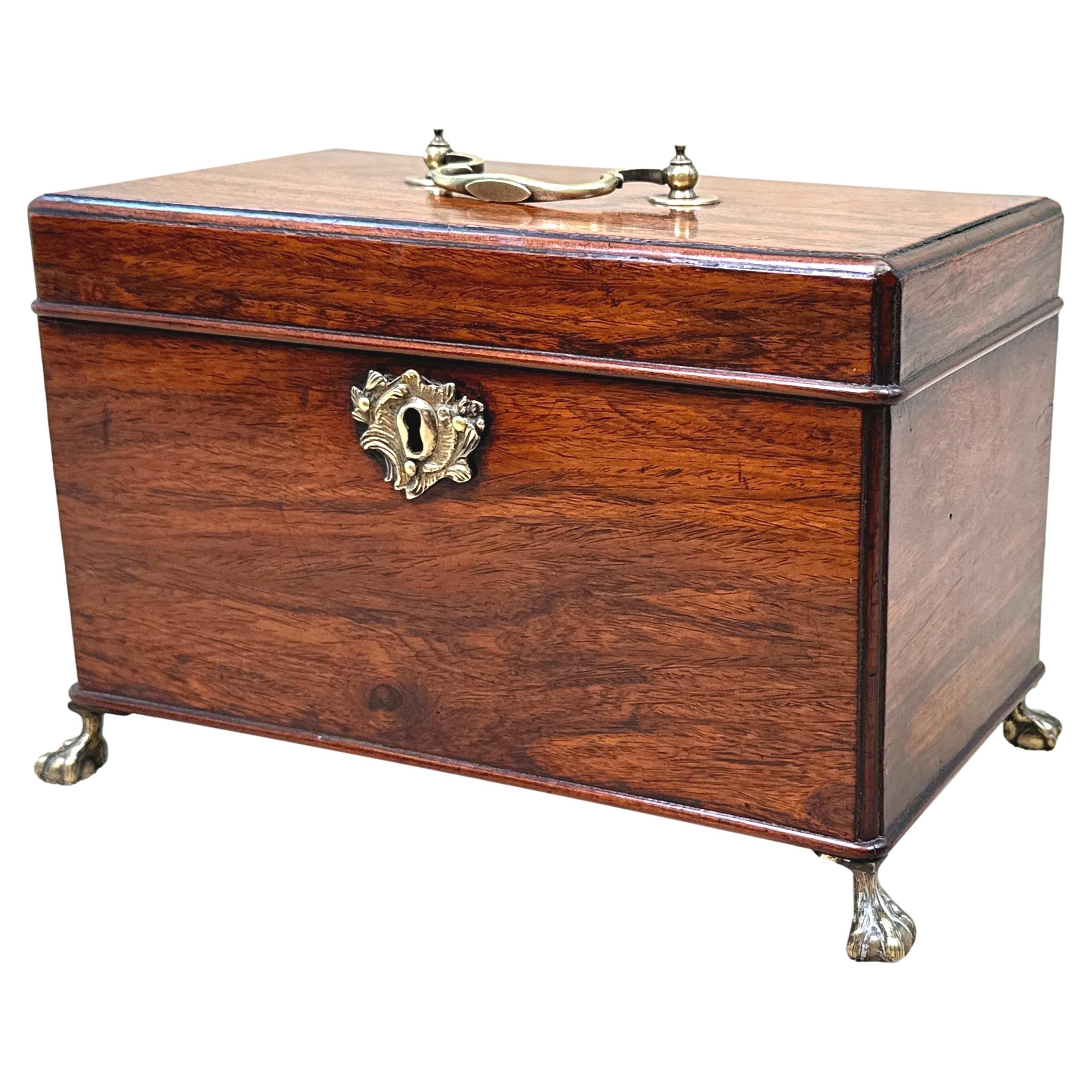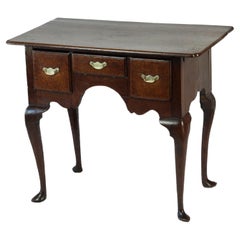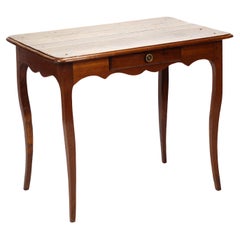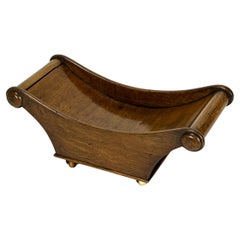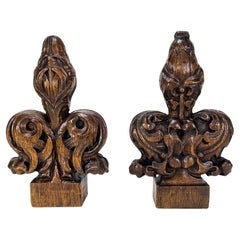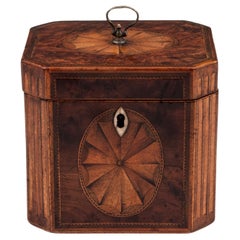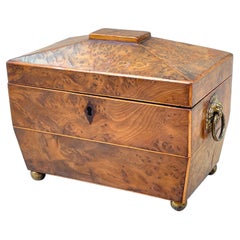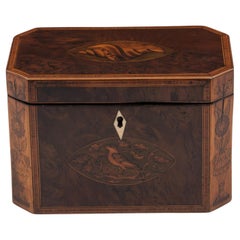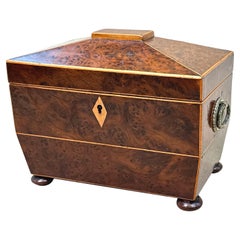Items Similar to Antique 18th-Century Georgian Burr Yew Tea Caddy—Elegant, natural wooden box
Want more images or videos?
Request additional images or videos from the seller
1 of 16
Antique 18th-Century Georgian Burr Yew Tea Caddy—Elegant, natural wooden box
$2,950
£2,253.64
€2,588.91
CA$4,223.61
A$4,620.15
CHF 2,407.16
MX$55,590.83
NOK 30,483.49
SEK 28,621.07
DKK 19,332.83
About the Item
Two hundred years of history, meticulously craftsmanship, rare wood, and natural beauty!
This beautiful tea caddy is dated circa 1780, is "of the period" Georgian style, and was made during the reign of George III--a time known as the golden age of British craftsmanship.
Georgian artistry is evident in this tea caddy's details. It has a rectangular shape with canted corners. This box is a smaller, more demure size--perfect for a tabletop or shelf. A delicate crossbanded border frames the front and lid. There's boxwood stringing on the edges. The marquise-shaped keyhole is finished with a bone escutcheon. If you open the hinged lid, you see the two traditional compartments--one for green tea and one for black. The interior has been repainted in black, and the box includes an antique key, although likely not the original.
The burr-yew veneer makes this caddy special. Two hundred years ago, yew wood was prized for its durability and honey-brown color. Even more prized than yew was burr yew--wood from the yew's scant burls and knotty growths. True craftsmen loved to work with this wood's complex, one-of-a-kind grains, swirls, wefts, and pips.
The burr yew plus the simple design give this caddy a natural, well-crafted elegance. The focus is on the beautiful wood, rich color, high craftsmanship, and wonderful patination. Unlike many tea caddies of this period, this one isn't burdened by overwrought Georgian trends, like inlays, cartouches, or a sarcophagus shape.
As collectors know, tea caddies have a charming history. The name evolved from "catty" or "Kati," a traditional Chinese weight of about 1 and 1/3 pounds. The wealthy, fashionable Georgians used tea caddies to store tea, a luxury item, in their drawing rooms, where their guests couldn't help but be impressed.
Today, tea caddies have practical and decorative uses. Practically, you might use one to store jewelry, mementos, or other treasures. Decoratively, your tea caddy might be the centerpiece of your side table, the attention-grabber for your shelf, or the keystone of your collection. Your tea caddy might complement a traditional interior or contrast with a modern look. No matter what, a tea caddy brings elegance, sophistication, and conversation to your home.
Contact us
•: Email us to view more pictures of, and to learn more about, this antique 18th-century Georgian burr yew tea caddy.
- Dimensions:Height: 5 in (12.7 cm)Width: 7.25 in (18.42 cm)Depth: 4 in (10.16 cm)
- Style:George III (Of the Period)
- Materials and Techniques:
- Place of Origin:
- Period:
- Date of Manufacture:Circa 1780
- Condition:Wear consistent with age and use. The lid sits every-so-slightly askew, but this doesn't interfere with the look and function of the caddy.
- Seller Location:Saint Helena, CA
- Reference Number:Seller: IX-03-311stDibs: LU10087243317112
About the Seller
No Reviews Yet
Vetted Professional Seller
Every seller passes strict standards for authenticity and reliability
1stDibs seller since 2024
- ShippingRetrieving quote...Shipping from: Saint Helena, CA
- Return Policy
Authenticity Guarantee
In the unlikely event there’s an issue with an item’s authenticity, contact us within 1 year for a full refund. DetailsMoney-Back Guarantee
If your item is not as described, is damaged in transit, or does not arrive, contact us within 7 days for a full refund. Details24-Hour Cancellation
You have a 24-hour grace period in which to reconsider your purchase, with no questions asked.Vetted Professional Sellers
Our world-class sellers must adhere to strict standards for service and quality, maintaining the integrity of our listings.Price-Match Guarantee
If you find that a seller listed the same item for a lower price elsewhere, we’ll match it.Trusted Global Delivery
Our best-in-class carrier network provides specialized shipping options worldwide, including custom delivery.More From This Seller
View AllAntique George II English Oak Lowboy Side Table, Circa 1740s
Located in Saint Helena, CA
This is a classic, beautiful lowboy side table. It's made of timeless English oak with a wonderful grain, age, and patina. It's "of the period" Georgian style from George II's reign....
Category
Antique 1740s English George II Lowboys
Materials
Oak
Antique 18th-Century French Louis XV Mulberry Side Table—Elegant and Simple
Located in Saint Helena, CA
Alluring French table with two centuries of history, rare wood, and prized details--all in the simple elegance of Louis XV's provincial style.
This 18th-century table dates to circa...
Category
Antique Late 18th Century French Louis XV Side Tables
Materials
Wood
Antique Regency Mahogany Cheese Coaster or Cheese Wheel Holder—Timeless Taste
Located in Saint Helena, CA
A beautiful, tasteful conversation piece
"A single man in possession of a good fortune must be in want of a wife," quips your dinner companion, Jane, as she rolls a 25-pound wheel of Stilton down the dining table. Today, this might seem odd. In Georgian times, however, this epitomized witty banter, proper etiquette, and, most importantly, the correct use of a cheese coaster.
Functional beauty in the Regency style
This is a fine example of a Georgian Cheese coaster...
Category
Antique Early 19th Century English Regency Serving Pieces
Materials
Wood, Mahogany
Pair of Antique 17th-Century Oak Church Pew Finals—Exquisite Hand-Carved Flowers
Located in Saint Helena, CA
Exquisite flowers in hearty oak
This is a pair of antique finials or decorative finishing elements. Dating circa 1680 and nearly 350 years old, they are remarkable ...
Category
Antique 17th Century English Baroque Abstract Sculptures
Materials
Wood, Oak
Set of Four Antique Louis XVI Chairs—Circa 1790s, Elm, Neoclassical Grace!
Located in Saint Helena, CA
Over two centuries of history, beautiful woodwork, and neoclassical elements, all with a stylish, contemporary accent!
This is a set of four antique Louis XVI chairs. They have more...
Category
Antique 18th Century Dutch Louis XVI Chairs
Materials
Elm
Pair of Antique 17th-Century French Chairs--Simple, functional beauty, Louis XIV
Located in Saint Helena, CA
Three hundred years of history, rich wood, simple beauty, and rare transitional form!
This is a near pair of early French chairs. They are dated circa 1690; imagine more than 300 years of history! They are made of two prized hardwoods--walnut and oak. The chairs are a rich, dark chocolate color with a wonderful patina. The chairs are similar in size, color, and construction, but they are not perfectly matched pairs.
The chairs have a simple, utilitarian beauty. Their open backrests have small curves decorating the top rail. The front legs and front crossbars have easy turnings. The legs are reinforced with classic H-stretchers. There are simple cylindrical feet in front and block feet in back. They are of the period and representative of an early, rustic, provincial Louis XIV style.
Each chair includes a custom hand-tied cushion made from a Scalamandre textile. The design features deep foliage in faded greens, yellows, and browns, with a few red speckles. The fabric is contemporary yet finished to look wonderfully old, faded, and worn.
The chair's historical interest will inspire the collector in you. Early on, most people sat on stools. During the 1600s, chairs--an innovation at the time--became popular. Early chairs were often backstools--more stools with backrests than our modern seats. This pair captures this unique moment of the evolution from stool to chair.
The chairs are smaller in size. Their backs are about 32 and 1/2 inches tall, and their seats are about 15 and 1/2 inches high. They are bigger than a child's chair but smaller than a dining chair.
The size is part of the historical context. For sure, people were smaller back in the 17th century—maybe 6 inches shorter or more on average. Most importantly, the small size meant these rare, highly valued items could be easily carried where needed—to a guest relaxing, a servant doing light chores, or a devotee praying. (Before we purchased these chairs, they had been in a family chapel at a manor house in the South of France for 100+ years.)
Today, you might use these chairs to provide a striking contrast with the rest of your home. The smaller size means they might accessorize your living room, study, hallway, or nook. As the chairs come as a pair, you might sit on them around a fireplace, use them to bookend a side table, or corner them around a coffee table. Wherever placed, these chairs communicate a beauty that's timeless, simple, and functional.
Email us to learn more about and to view more pictures of this pair of antique 17th-century French chairs.
Category
Antique 17th Century French Louis XIV Chairs
Materials
Oak, Walnut
You May Also Like
Georgian Burr Yew Tea Caddy
Located in Northampton, GB
Burr Yew Inlaid Tea Caddy Circa 1780
From our Tea Caddies collection, we are thrilled to offer this square Georgian Burr Yew wood inlaid Tea Caddy. The Caddy of square form with c...
Category
Antique Late 18th Century English Georgian Tea Caddies
Materials
Boxwood, Yew
Regency Burr Yew Tea Caddy
Located in Bedfordshire, GB
A Delightful Early 19th Century, Regency Period, Burr Yew Wood Tea Caddy Of Sarcophagus Form Having Boxwood Strung Decoration, Original Ormolu Handles To Side...
Category
Antique Early 19th Century English Regency Tea Caddies
Materials
Yew
Antique George III English Burr Yew Wood Tea Caddy
Located in Northampton, GB
From our Tea Caddy collection, we are delighted to offer this Antique Burr Yew Tea Caddy. The Tea Caddy of rectangular shape is beautifully finished in veneered Burr Yew wood, edged ...
Category
Antique Late 18th Century British George III Jewelry Boxes
Materials
Boxwood
Burr Yew 19th Century Tea Caddy
Located in Bedfordshire, GB
A Very Attractive And Good Quality Early 19th Century Regency Period, Burr Yew Wood Tea Caddy Having Boxwood Strung Decoration Throughout, The Hinged Pagoda Top Enclosing Two Lidded ...
Category
Antique Early 19th Century English Regency Tea Caddies
Materials
Yew
Georgian Octagonal Yew Wood Tea Caddy
Located in Bedfordshire, GB
An Early 19th Century, George III Period, Burr Yew Wood Tea Caddy Of Octagonal Form, Having Superbly Figured Veneers And Attractive Strung Decoration Throughout, The Hinged Lid Enc...
Category
Antique Early 19th Century English Georgian Tea Caddies
Materials
Yew
18th Century Padouk Wood Tea Caddy
Located in Bedfordshire, GB
A Very Rare 18th Century Padouk Wood Rectangular Tea Caddy Of Rectangular Form, Having Original Brass Handle To Hinged Top Enclosing Divisions, Raised On Elegant Original Brass Claw ...
Category
Antique Mid-18th Century English Georgian Tea Caddies
Materials
Padouk
More Ways To Browse
Chinese Weights
Antique Grabber
Burr Yew
18th Century Wooden Boxes
Wooden Tea Box
Antique Chinese Lacquer Tea Caddy Tea Caddies
Antique Tea Container
Oval Tea Caddy
Georgian Satinwood Tea Caddies
Paper Quilling
Tortoise Shell And Ivory Box
Tunbridge Tea Caddy
Blue And White Tea Caddy
Dutch Tea Caddy
Tea Caddy Feet
Victorian Walnut Tea Caddies
Wooden Tea Box
Antique Pewter Tea Caddy
